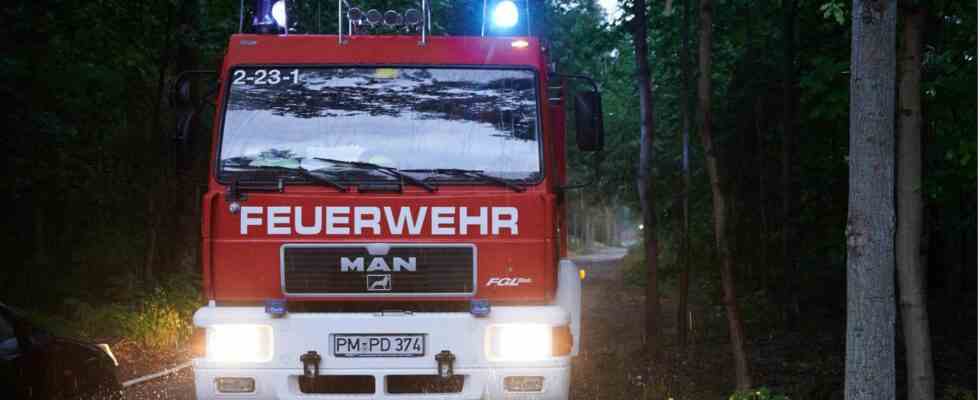Rain finally provided the decisive turning point in the fight against the forest fires in Brandenburg: Heavy rainfall contained the flames on hundreds of hectares in forest areas near Beelitz and Treuenbrietzen southwest of Berlin on Monday. “There is really no longer any danger for the localities,” said the spokeswoman for the Potsdam-Mittelmark district, Andrea Metzler, in the morning.
More than 600 people were able to return to their homes in three districts of Treuenbrietzen. This was announced by the local authorities. In Beelitz, too, the residents of three streets that had been evacuated as a precaution were able to go home. However, hundreds of firefighters continued to work. Because wind could fan the deep-seated embers in the forests again.
At the weekend, two large forest areas burned in the Brandenburg district of Potsdam-Mittelmark, only about 20 kilometers apart. Huge plumes of smoke hung over the area. With changing winds, the fires spread rapidly. About 200 hectares of forest burned in each of the two forest areas – each covering an area of almost 300 football pitches. The situation was highly dramatic, said Brandenburg’s Interior Minister Michael Stübgen (CDU) on Monday during a visit to the fire area. A barrage of fire was only stopped 200 meters before the first residential buildings in Beelitz.
Evacuations in three villages and some streets of Beelitz
In the Treuenbrietzen districts of Frohnsdorf, Klausdorf and Tiefenbrunn, 620 people were affected by the evacuations. Only seven residents stayed in the emergency accommodation in the town hall, the others stayed privately, said the spokesman for the crisis center, Jan Penkawa. In Beelitz, according to Mayor Bernhard Knutz (independent), there were accommodations in gyms, pensions and asparagus farms. These also hardly had to be used.
Embers are still a danger for weeks
The main concern now is the embers in the ground, which could last for three to four weeks because they are up to 70 centimeters deep, said the spokeswoman for the district. In the heat and wind, the fires could flare up again quickly.
Firefighting operations by the Bundeswehr and the Federal Police
Interior Minister Stübgen praised the Bundeswehr’s quick help over the weekend with five fire-fighting helicopters: “We are very grateful to the Bundeswehr for reacting so quickly,” said Stübgen. The Federal Police also flew almost 80 missions with helicopters and extinguishing containers, so-called Bambi Buckets. A armored recovery vehicle from the Bundeswehr supported the cutting of firebreaks.
Ammunition in the forest floor makes extinguishing work difficult
Extinguishing the fire area around Treuenbrietzen was particularly difficult because there were ordnance in the ground from the time of the Second World War. These are legacies from the fight for Berlin at the time, said a ministry spokesman. The firefighters were therefore unable to approach the fire directly.
Therefore had to be extinguished from the air. According to the Ministry of the Interior, almost 330 tons of explosive ordnance were found and destroyed in Brandenburg last year alone. In areas with an increased risk of forest fires and in Oranienburg, which is particularly affected, areas totaling 75 hectares have been examined since last year and around 35 tons of explosive ordnance recovered.
Prime Minister Woidke is asking for help from the federal government
Prime Minister Dietmar Woidke (SPD) called on the federal government to help with military contamination. “Our main problem was the military burden on the areas where these fires broke out,” said Woidke. Firefighters could not have entered some of them. “We have somewhere between 150 and 200 hectares of forests around Berlin that are heavily militarized,” said Woidke. He spoke of “incendiary bombs” for forest fires. “It’s ammunition from 150 years of German history that can be found there.”
In 2018 there were already evacuations in Treuenbrietzen
Many people in Treuenbrietzen had had to leave their homes for the second time – after a forest fire that was also large on 400 hectares in 2018. This included Anita Laatz, a resident of Frohnsdorf. When she returned on Monday, she said that with such an evacuation, you don’t know what it will look like when you come back: “You haven’t slept at night, you’re just restless.” Looking at her suitcase, she said: “Now I’ll unpack it again, or will I leave it? It’s supposed to be warm again.”
Another resident came back to his home with his trailer. He spent the night in the caravan and then showered and had breakfast with a friend, he reported calmly. “It worked well that way.”

